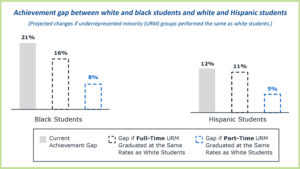Editor’s note: This article comes from EAB, a Gold Circle corporate partner of the American Association of Community Colleges (AACC). Corporate partner articles do not necessarily reflect the opinions of AACC.
Nearly half of part-time community college students believe they’ll graduate within two years, according to the Center for Community College Student Engagement. In reality, fewer than 8 percent will graduate in four years, according to Complete College America, twice as long as predicted.
Why do so many students have such an unrealistic expectation of time to graduation? More importantly, why are we falling so short on helping them succeed?
The issue may be we are not setting our part-time students up for success. And given the typical composition of part-time students, which are disproportionately underrepresented populations, our inability to serve part-time students is inextricably linked to our equity challenge.
Our latest white paper, “Reframing the Question of Equity,” examines community college demographics, particularly part-time students: who they are, who they aren’t and how they are critical to the larger equity narrative. Our data shows that closing the achievement gap may depend on how focused we are on success initiatives for part-time students.
Focus on the achievement gap
Today’s students are more diverse than ever and bring rich, varied life experiences to our campuses. Many are parents, work full-time, are first-generation or are military-affiliated.
They are also very likely to enroll part-time: 84 percent of Hispanic students and 81 percent of black students enroll part-time for at least one term, as compared to 72 percent of white students.
At the same time, outcomes of students from underrepresented minority (URM) groups are worse than those of their white peers. The National Center for Education Statistics (NCES) reports that while 54 percent of people who are white have earned an associate degree by the time they’re 29 years old, just 32 percent of people who are black and 27 percent of those who are Hispanic have earned an associate degree.
Across the past year, EAB investigated how the overall achievement gap would change if URM groups graduated at the same rates as their white peers. Our analysis found that if full-time students from URM populations graduated at the same rates as full-time white students, the overall achievement gap between black and white students would improve by 5 points, while the gap between Hispanic and white students would change by just 1 point.
However, if we focus on closing the achievement gap among part-time student populations, the gap between black and white students would close by 13 points — a difference of 62 percent — and the gap between Hispanic and white students would improve by 7 points — closing the gap by 58 percent.

Source: EAB, “Reframing the Equity Question: Understanding the Growing Importance of Success for Community Colleges’ Part-Time Students,” 2018.
It’s a relatively simple equation. Because the proportion of underrepresented minority, low-income and first-generation students is so high at our colleges, and because they are more likely to attend part-time, student success initiatives that only target full-time students will not close the achievement gap as effectively as those that focus on part-time students.
Three ways to remove barriers
To reduce achievement gaps in a meaningful way, we need to address the institutional barriers that disproportionately affect part-time students. Below are three areas of the part-time student experience can benefit from a closer look:
Onboarding: After secret shopping community college campuses, we found that, on average, students must return to campus four times before they complete the onboarding process. The onboarding process is complicated and students are misdirected, transferred between departments, or simply can’t get transactions completed in their first visit to campus. More than 70 percent of part-time students work more than 20 hours a week, according to NCES, and they don’t have the extra time to spare.
Colleges should reduce their students’ need to keep returning to campus by giving them the information they need up front and providing customized to-do lists to help them stay on track throughout matriculation.
Academic planning: In an effort to encourage full-time enrollment, colleges often present academic plans in term-by-term formats designed for full-time students. Part-time students find it difficult to figure out how to make sense of course sequences on their own. This problem is amplified with their schedule limitations, often necessitating a visit to their advisors — which demands time on campus that they don’t have.
Instead, we need to empower students to customize an academic plan online that works for their schedule and updates to inform them about actual time to degree based on their enrollment plans.
Student services: Competing priorities make it difficult for part-time students to spend much time on campus. Work schedules often demand evening classes, and even when students are able to stay on campus a bit longer around their class times, they find many student resources closed. Similarly, when advisors are forced to spend much of their time planning schedules and choosing classes, it is difficult for them to find the time to conduct proactive outreach to engage and support students. Technology can help to make these virtual connections, so students feel supported and staff feel empowered to engage with students who are hard to reach.
Agile, student-centric and future-looking
Some have told me that part-time students simply don’t graduate and we should therefore direct our efforts to the more promising pool of full-time students. To that, I point out that if it were any other population of students, it would be criminal to turn our backs and say, “They can’t be helped.”
This is not to say that I don’t support 15-to-Finish efforts. Student who are able to enroll full-time should. But I also have vivid memories of advising students with children and full-time jobs. For them, full-time enrollment is a losing proposition: lost financial aid, lost motivation and lost self-esteem.
Juggling personal, professional and academic demands is no small feat — let’s meet our part-time students where they are. Our students’ lives will continue to demand balance and we must provide access to the support they need to fulfill their goals.

